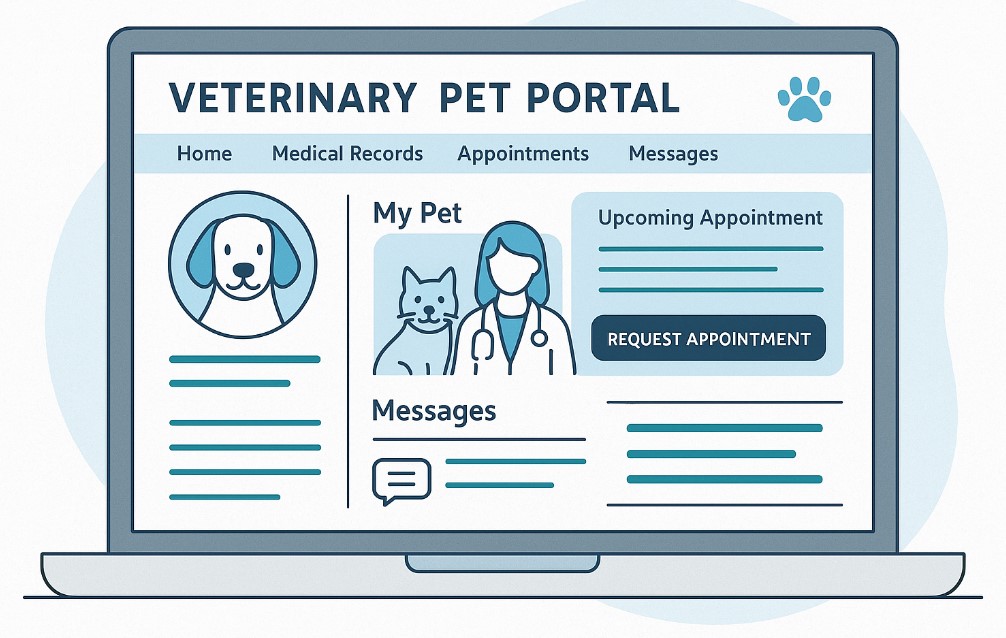If you’re running a veterinary clinic, chances are you’re already juggling a lot. From keeping furry patients healthy to handling phone calls, appointment scheduling, and medical records, your team has plenty on their plate. Now imagine a world where much of that communication and organization could flow more smoothly, with less stress for both staff and pet owners. That’s the beauty of a well-designed veterinary pet portal.
Veterinary clinics everywhere are beginning to realize the power of digital tools to enhance client engagement and streamline operations. A thoughtfully designed pet portal can do wonders, making life easier for your team and more convenient for your clients. It can even help you stand out from competing clinics in your area.
If you’re not sure where to start, certain resources can point you in the right direction and help you build a solid online presence just like this one is doing: https://www.demandforce.com/industries/digital-marketing-for-veterinarians/.
What Is a Veterinary Pet Portal?

Before we dig into the design aspects, let’s clear up what a pet portal is. In simple terms, it’s an online platform where pet owners can manage various aspects of their pet’s care. This might include viewing medical records, requesting appointments, checking vaccination histories, getting reminders for upcoming visits, paying invoices, and even messaging the clinic.
A pet portal acts as a communication bridge between the clinic and the client. It helps pet parents stay organized and informed without needing to pick up the phone or drop by the clinic in person.
Now that we know what a pet portal does, let’s look at how to design one that truly makes an impact.
Keep It Simple and Easy to Use
Pet owners come from all walks of life, and not all of them are tech-savvy. That’s why simplicity should be at the heart of your portal’s design. From the first login to the final action, every click should feel intuitive.
Use clean layouts, clear buttons, and easy-to-read text. Make sure the main menu is easy to find and labeled with obvious terms like “Appointments,” “Pet Records,” and “Messages.” Avoid cluttered pages that overwhelm the user with too many options.
Think of it this way: if someone’s dog is sick at 10 p.m. and they’re logging into the portal to send you a message, the last thing they want is to dig through confusing menus. They need quick answers and simple navigation.
Mobile-Friendly Design is a Must

Most people are using their smartphones for everything, including checking on their pets. That means your veterinary portal should work just as well on mobile as it does on a desktop.
A mobile-friendly portal ensures pet owners can access information on the go, whether they’re at the park, in the car, or at work. If a client needs to pull up vaccination records while boarding their dog or show a medication schedule at the groomer, they should be able to do so in seconds.
Responsive design, large tap-friendly buttons, and easy scrolling all contribute to a better mobile experience.
Personalization Makes a Big Difference
Pet owners appreciate a personal touch, especially when it comes to their beloved animals. A great pet portal should allow users to see their pet’s name, photo, breed, birthday, and health records as soon as they log in.
You can also customize reminders and messages. For example, instead of sending a generic message like “Your pet has an appointment,” make it personal: “Hi Sarah, just a reminder that Bella’s dental cleaning is scheduled for Thursday at 10 a.m.”
These small details make the experience feel more thoughtful and connected, which builds trust and loyalty.
Offer Secure Messaging with the Vet
Many pet parents have quick questions that don’t require a full appointment, like “Can I give my dog Benadryl for allergies?” or “Is it okay that my cat missed one dose of her medication?”
Secure messaging within the portal gives clients a safe way to reach out and receive timely answers. It also cuts down on phone calls and voicemails, making life easier for your team.
Just be sure to set realistic expectations. For example, you might let clients know that messages will be answered within 24 hours, or that certain topics require a phone consultation.
Appointment Requests and Reminders

One of the most appreciated features in any pet portal is the ability to request and confirm appointments online. No one enjoys sitting on hold during lunch break, and online booking eliminates that frustration.
Set up your system to allow clients to pick their preferred date and time, then confirm it via email or in-app notification. Automated reminders can also go a long way in reducing no-shows. These reminders can be sent via text, email, or both, depending on the client’s preference.
Even better, send reminders for routine care like vaccines, dental cleanings, or wellness checks. These nudges help keep pets healthy and clients loyal.
Make Payment Easy
Adding a payment feature to your portal is a win-win. Clients can settle bills online without needing to swipe a card at the front desk, and your team spends less time chasing down invoices.
Offer secure payment options and include clear details about what the charges are for. Giving clients access to billing history also helps reduce confusion or disputes.
The more convenient you make payments, the faster you’ll get paid — and the more clients will appreciate the experience.
Educational Resources Build Loyalty
Want to really impress your clients? Include a section in your pet portal with trusted educational resources. You can share articles, videos, or tips about pet nutrition, grooming, exercise, and common health concerns.
Clients love learning more about how to care for their pets, and having that knowledge come directly from their trusted veterinary clinic builds even more confidence in your team.
You can also use this area to post updates, seasonal advice (like flea prevention tips in spring), or even introduce new services.
Privacy and Security Are Non-Negotiable
With sensitive health information involved, your pet portal must be secure. Clients need to know their data is protected, especially when it comes to things like credit card payments and medical histories.
Use encrypted connections and password protection. Work with software providers who prioritize HIPAA-compliant systems, even in veterinary settings, to ensure you’re handling data responsibly.
Let clients know what steps you’re taking to protect their information. Transparency here goes a long way toward building trust.
Ask for Feedback and Improve Often
Your portal should evolve with your clients’ needs. One of the best ways to ensure your system is working well is by asking for feedback. Include a short survey link within the portal, or ask for opinions during check-in or checkout.
Simple questions like “Was it easy to schedule your pet’s appointment online?” or “Do you use the portal for messaging?” can give you valuable insight. Use that feedback to fix problems, add features, or simplify steps.
Final Thoughts
Designing a veterinary pet portal that clients love isn’t about fancy tech or complicated features. It’s about making everyday tasks easier and more convenient for the people who trust you with their pets.
When you focus on user-friendly design, personalization, security, and meaningful features like appointment booking and secure messaging, you’re creating more than just a digital tool. You’re creating a smoother experience that shows clients you truly care.
A great pet portal builds stronger relationships, increases client satisfaction, and ultimately supports better care for every animal that walks through your doors. And when pet parents are happy, they’ll keep coming back, time and time again.




